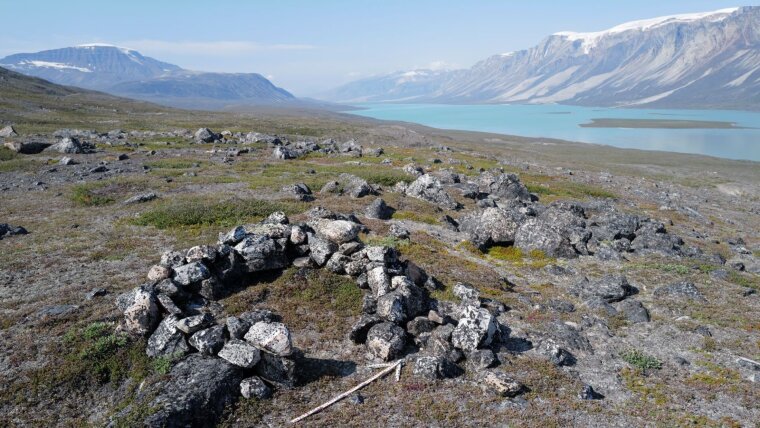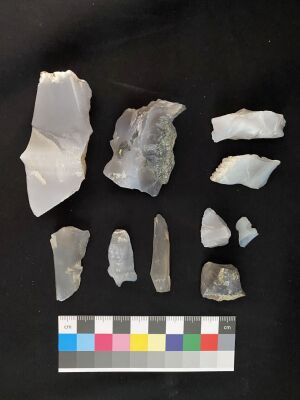
- Research
Published: | By: Sebastian Hollstein
PhD student Clemens Bock with one of the stone artefacts found.
Image: Clemens Pasda (Universität Jena)For thousands of years, the lives of many Inuit on Greenland were characterized by a regular rhythm: during the winter, they fished along the coast and hunted whales, seals and other marine mammals; in the summer, they moved inland and hunted caribou (reindeer). While the coastal settlements, which were mostly used over a longer period of time, have been well researched archaeologically, far less is known about the more mobile life in summer.
That is why archaeologists from the Professorship of Prehistory at Friedrich Schiller University Jena set out in summer 2025 to follow in the footsteps of Arctic caribou hunters and made a remarkable discovery: for the first time, they found stone artefacts in the interior of the Nuusuuaq Peninsula in western Greenland that prove that Inuit people were already hunting there in the summer before our time. The expedition took place under the patronage of the »Greenland National Museum and Archives«.
»There were at least two waves of Inuit settlement in Greenland, both originating in Alaska: the so-called Palaeo-Inuit first reached the island around 2500 BC, but disappeared again around the beginning of our time. A second phase—the so-called Thule culture—began around 1200 AD. The Inuit still living in Greenland today are also descended from this culture«, declares Prof. Dr Clemens Pasda from the University of Jena. During both phases, up until the 1950s, the Arctic inhabitants maintained a seasonal semi-nomadic lifestyle that had hardly changed over the millennia.
Summer camp and caribou hunting site
This is why Clemens Pasda and his doctoral student Clemens Bock came across numerous remains of structures built by the Inuit during their four-week expedition to the caribou hunting camp Nernartuut (which in translation means »place with many saxifrage flowers«) on the Nuussuaq peninsula. »We mainly see the remains of overnight structures, i.e. small, round to rectangular stone walls that served either as outer walls of larger tent houses or as windbreaks for so-called hunters beds, which had no roof«, explains Clemens Pasda. »Leather, wood and other organic material has not been preserved in the harsh environment.«
The archaeologists also found caribou hunting sites, i.e. cairns lined up over several hundred metres, which served to guide the caribou into a lake or to hunting stands where the hunters could kill them more easily. The Inuit stored their prey in meat depots under small piles of stones, the remains of which can still be found today.
Despite the fact that the dwellings have remained similar over the centuries, the Jena experts made a discovery that helps with dating: »My colleague Clemens Bock found stone tools that were only used in the early phase between 4500 and 2000 years ago«, says the Jena prehistorian. »This means we now know for certain that the Inuit were already visiting this hunting ground, which is about half the size of Thuringia, during this period.«
Archaeological map extended to the north
Some of the stone artefacts found. These were handed over to the nearby Ilulissat Museum, which provided logistical support for the expedition.
Image: Clemens Pasda (Universität Jena)The experts from Jena documented a total of around 100 new sites by photographing and sketching them. They handed over special finds, such as the stone artefacts, to the nearby »Ilulissat Museum«, which provided logistical support for the expedition. »These artefacts give us a better understanding of how the Inuit spent their summers on the peninsula«, explains Clemens Pasda.
In late spring, entire families travelled inland by dog sled and settled in large tent camps. While the women fished in the local waters, the men initially returned to the coast to fish there as well. In July, they travelled on foot to their families in the now snow-free steppe and hunted caribou, leaving the central camp for longer periods of time, as evidenced by smaller campsites. With the first snowfall, they finally brought their prey and families back to the coast by dog sled.
»With this work we have extended the archaeological map of Greenland to the north«, summarizes Clemens Pasda. »Until now, comparable research has mainly focused on more southern regions. We have now been able to show how rich and diverse the skilled and intelligent way of life of the people there has been for several millennia in the far west of Greenland.« Next year, the prehistorian, who has been researching the world's largest island for around 30 years, plans to return there and resume his search for traces of the caribou hunters.
Contact:
07743 Jena Google Maps site planExternal link

